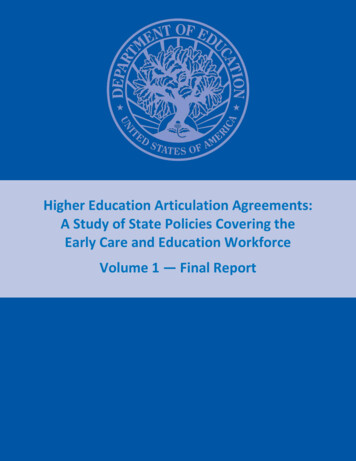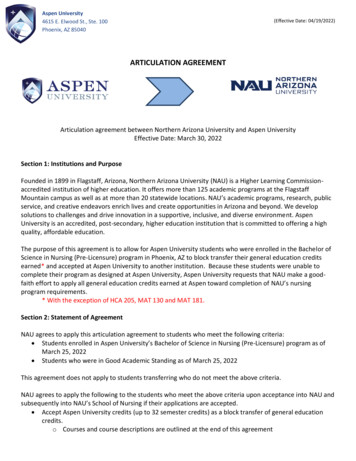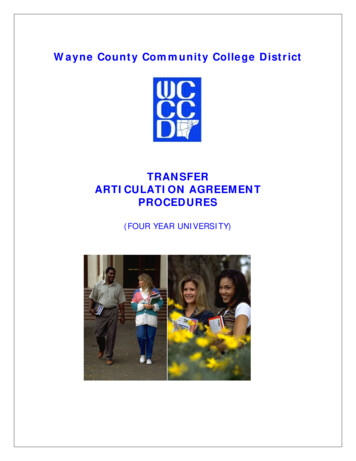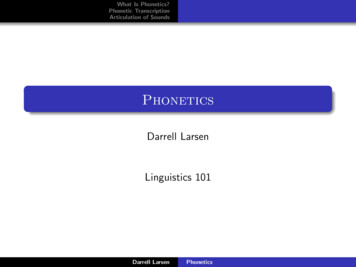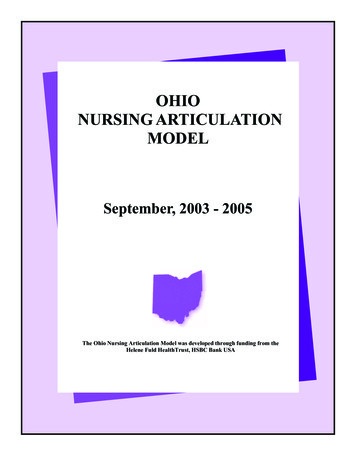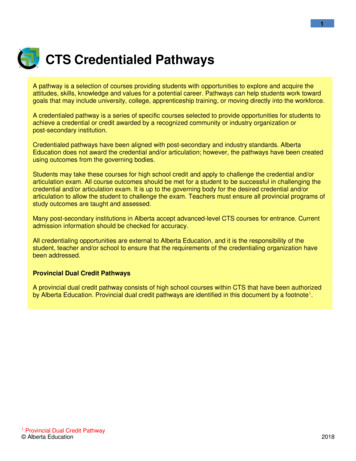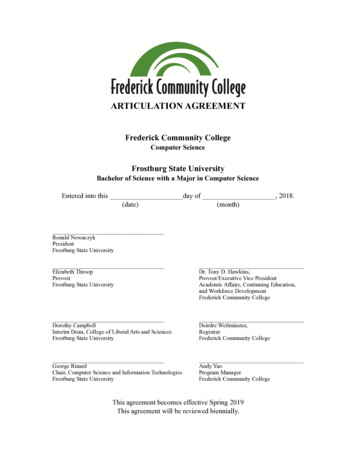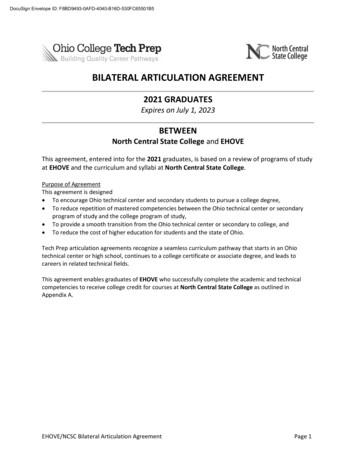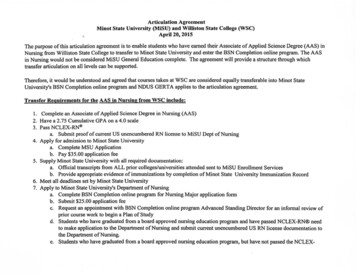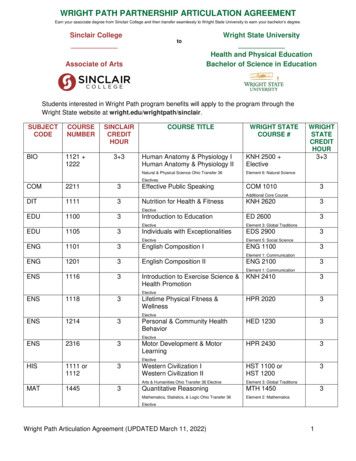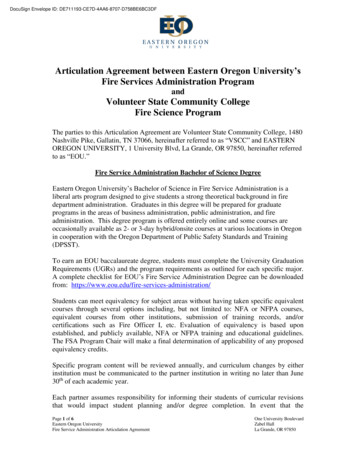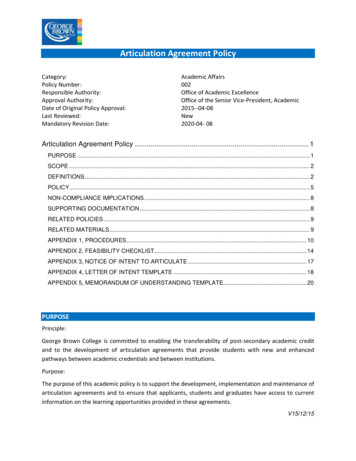
Transcription
Articulation Agreement PolicyCategory:Policy Number:Responsible Authority:Approval Authority:Date of Original Policy Approval:Last Reviewed:Mandatory Revision Date:Academic Affairs002Office of Academic ExcellenceOffice of the Senior Vice-President, Academic2015--04-08New2020-04- 08Articulation Agreement Policy . 1PURPOSE . 1SCOPE . 2DEFINITIONS . 2POLICY. 5NON-COMPLIANCE IMPLICATIONS . 8SUPPORTING DOCUMENTATION . 8RELATED POLICIES . 9RELATED MATERIALS. 9APPENDIX 1, PROCEDURES . 10APPENDIX 2, FEASIBILITY CHECKLIST. 14APPENDIX 3, NOTICE OF INTENT TO ARTICULATE . 17APPENDIX 4, LETTER OF INTENT TEMPLATE . 18APPENDIX 5, MEMORANDUM OF UNDERSTANDING TEMPLATE. 20PURPOSEPrinciple:George Brown College is committed to enabling the transferability of post-secondary academic creditand to the development of articulation agreements that provide students with new and enhancedpathways between academic credentials and between institutions.Purpose:The purpose of this academic policy is to support the development, implementation and maintenance ofarticulation agreements and to ensure that applicants, students and graduates have access to currentinformation on the learning opportunities provided in these agreements.V15/12/15
Articulation Agreement Policy Page 2SCOPEArticulation agreements between George Brown College and secondary schools (which may be dualcredit initiatives, a specific memorandum of understanding or a similar document), internal articulationsbetween George Brown College programs, and external articulations between George Brown Collegeand accredited post-secondary institutions at the provincial and national level.This policy excludes international articulation agreements.DEFINITIONSThis list includes an explanation of terms and abbreviations used within, or applicable to, thisArticulation Agreement Policy.Word/TermDefinitionAdvanced StandingAdvanced Standing refers to credits granted upon admission that enabledirect entry to the second, or higher, semester. Advanced standinggrades are granted to students applying to a semester of study otherthan the entry level semester and are recorded on the student record asAS and not included in GPA calculations.ArticulationArticulation is a broad term that relates to various methods wherebystudents can receive transfer credit for specific course work takenpreviously in a different program or a different institution. Through theprocess of articulation, institutions assess courses offered at otherinstitutions to determine whether to grant course credit toward theirown programs or credentials.Articulation AgreementAn articulation agreement is an official agreement between two(bilateral) or more (multilateral) institutions- a secondary school, collegeor university- that authorizes studies undertaken in specific programs atone institution to be credited toward specific programs at anotherinstitution. Articulation agreements may apply to programs within aninstitution as well as to external accredited partners at the local,provincial and national level.Block CreditsA group of courses taken at one institution which are consideredequivalent to a group of courses at another institution. This leads toadmission to a semester higher than semester one.Block TransferBlock transfer refers to advanced standing for a group of credits orcourses at one institution based on their equivalence to a defined set ofcourse or program learning outcomes at another institution. Blocktransfer enables direct entry to the second, or higher, semester. BlockTransfer does not require course-by-course equivalency assessment.Bridge Semester/CoursesCourse or set of courses that students take to fill gaps in their learningfrom one program in order to enter another program, for example froma diploma to a degree program in the same area of study. Students
Articulation Agreement Policy Page 3articulating into certain programs must successfully complete a bridgesemester as a condition of entry into the advanced program pathway.Co-OpNOTE: Definition under review. Co-Op is a commonly used abbreviationfor Co-operative Education and are work experiences where studentswork in an industry related to their program of study. In contrast to fieldplacement, co-op terms are required to be paid placements. Co-opplacements may be one term longer than the standard lenth of theprogram.CredentialAn official document- certificate, diploma, undergraduate degree orgraduate degree- issued by an individual college or university uponcompletion of all curriculum requirements and fulfilment of all financialobligations to the institution.CreditA unit of value assigned to a course for the purpose of counting thevalue towards a credential such as a certificate, diploma or degree. Thenumber of credits received by students for a course varies amonginstitutions. At George Brown College, one credit equals one hour ofinstruction per week.Post-secondary credit is awarded to students who have demonstratedsuccessful completion of a module or unit which represents a portion ofan academic credential. In order for this to occur, a student must meeta minimum standard, commonly known as a “pass,” in the assessmentprocess. A higher standard may be required and specified.Credit TransferCredit transfer is a process of giving recognition for previous academicachievement such as course by course equivalencies, block credittransfer or prior learning assessment and recognition.Curriculum (program of study) Curriculum refers to a defined academic program plan for a course,program, major, specialization or other academic designation. The termcurriculum may be used to describe the learning outcomes, coursedescriptions and content, learning activities, teaching and learningmethods, assessment and evaluation.ExemptionCredit for courses taken at another accredited institution that areequivalent in level and scope to George Brown College courses. At GBC,course exemptions are used for the evaluation of course to courseequivalency. Courses assessed and approved for exemption arerecorded as EX on the student record. An EX is not included in the GPAcalculations.GradeA grade is a measure of a student’s academic performance. It may beexpressed as a number (percentage) or letter on a rating scale ofunsatisfactory to excellent. Grading policies vary widely amonginstitutions. See Office of the Registrar (OR) Policies for the GeorgeBrown College Grading Scheme.Grade Point Average (GPA)A GPA is a measure of a student’s academic achievement at the end ofa semester, year, term or program. It is calculated by dividing the sum
Articulation Agreement Policy Page 4of the grade point values by the sum of the credits. GPA may becalculated by term, program or overall.Letter of IntentMemorandum ofUnderstandingONCAT/ONTransfer.caA Letter of Intent or LOI can be described as an informal agreementbetween parties on a specific area or narrow set of areas that does notconstitute a legally binding document but instead recognize thatcollaboration would be of mutual benefit and would serve as anindication of continued interest in joint projects.A Memorandum of Understanding or MOU is a formal agreementbetween two or more accredited academic institutions that promotesnew program pathways through formal credit recognition of previouslearning.Established in 2011, the Ontario Council on Articulation and Transfer(ONCAT) was created to enhance student pathways and reduce barriersfor students looking to transfer among Ontario's 44 publicly fundedpostsecondary institutions.ONCAT maintains the ONTransfer.ca website, an online searchabledatabase which provides students with up-to-date, authoritativeinformation on block credit agreements, and pathways betweenpostsecondary institutionsPathwaysPlacement- Clinical, Field,IndustryPrior Learning Assessmentand Recognition (PLAR)Postsecondary EducationQuality Assessment Board(PEQAB)Reach Back CoursesPathways describe the academic routes whereby students have theability to move from one academic credential to another.Placement within a program refers to work experience that is scheduledat a company, agency, institution, business, hospital or otherorganization related to the program of study . Unlike co-op, placementsare not required to be paid positions.PLAR is defined as a systematic process of identification, documentationand recognition of formal and informal skills and knowledge.Recognition of prior learning can be applied as credit toward the courserequirements of education and training programs.The Postsecondary Education Quality Assessment Board is an armslength advisory agency that makes recommendations to the Minister ofTraining, Colleges and Universities of Ontario on applications forministerial consent. Ministerial consent to offer a degree or part of adegree program is required by all private organizations, either for profitor non-profit, all CAATs, and public institutions based outside of theprovince.The term ‘reach back’ is not used at GBC but may be used at otherinstitutions. Reach back or foundation courses are courses within a
Articulation Agreement Policy Page 5program which are required to meet graduation requirements. They aredetermined as a result of program mapping and course equivalencydetermination during the development of a articulated programpathway.Receiving InstitutionThe institution to which a student intends to transfer credits. In anarticulation agreement, the receiving institution grants credit forcourses completed at the sending institution.Requirements for GraduationCourses and conditions that must be completed before a credential isawarded, with terms and standards specific to the institution. Thisincludes successful completion of compulsory and optional subjects,general education requirements, residency, and program GPA(academic standing) at a defined minimum level.ResidencyResidency refers to the minimum amount of time or courserequirements that must be completed to earn an academic credentialat a college or university. George Brown College post secondaryprograms require a minimum of 25% of a program of study to beearned at Geroge Brown to meet residency requirements. ContinuingEducation programs require a minimum of 50%.SemesterSemester refers to the level of the program pathway in which a studentis registered. Each semester usually falls within a single term.Sending InstitutionThe institution from which a student intends to transfer credits. In anarticulation agreement, the receiving institution grants transfer creditfor courses completed at the sending institution.TermThe calendar date range in which registration exists. Each academic yearis divided into three terms- Fall (September-December), Winter(January-April) and Spring ( May to August).Transfer CreditsTransfer credits are those resulting from study done elsewhere, whichare used to determine individual course exemptions, or entire terms ofAdvanced Standing toward a George Brown College program. SeeExemption.TransferabilityThe degree to which credits can be moved between post-secondaryinstitutions, among colleges and between colleges and universities.POLICY1.0 General Principles1.1. Commitment to program pathways and collaboration between institutions throughtransfer credit
Articulation Agreement Policy Page 61.1.1.George Brown College is committed to the building of partnerships andcollaboration between its own programs and with accredited secondary and postsecondary institutions to develop and enhance new program pathways forstudents through transfer credit.1.1.2.George Brown College reserves the right to maintain its autonomy in thedevelopment and delivery of its programs while acknowledging the institutionaldifferences in the academic policies and procedures of partnering organizations indeveloping and implementing transfer credit agreements.1.2. Quality Assurance1.2.1.Consistency of process in articulation agreement development is maintainedthrough alignment to George Brown College policies and compliance withprovincial organizations such the Ontario Council on Articulation and Transfer(ONCAT) and the Postsecondary Education Quality Assessment Board (PEQAB).1.2.2.Academic integrity is ensured through transfer credit evaluation and equivalencydetermination by program experts.1.2.3.Consultation and collaboration with departments impacted by articulationagreements during the development process ensur that institutional capacity andacademic advisement are in place to support transfer student success.1.3. Clarity in Implementation, Maintenance and Review ProcessesArticulation agreements are developed using transparent and approved businessprocesses and templates that provide:1.3.1.Consistency in support of administrative management, oversight and qualityassurance.1.3.2. Defined steps, roles and accountabilities in the development of articulationagreements.1.3.3.Academic departmental accountability in renewal, review, revision, evaluation andappropriate distribution of agreements.1.4. Clearly defined roles and responsibilities of Articulating PartnersArticulation agreements specify accountabilty and role definition:
Articulation Agreement Policy Page 71.4.1.George Brown College as the Sending or Receiving InstitutionGeorge Brown College may act as either the initiator or recipient of a request tocreate a credit transfer/articulation agreement. Such an agreement would involveeither providing students from George Brown College with the opportunity totransfer certain credits to another institution and credential (in which case, GeorgeBrown is referred to as the ‘Sending Institution’), or providing students from otherinstitutions an opportunity to transfer certain credits to a program at GeorgeBrown College (in which case, George Brown College is referred to as the‘Receiving Institution’).1.4.2.George Brown College Academic Departments/DivisionsGeorge Brown College academic departments which are named in articulationagreements are accountable for the accuracy of information and the quality of theacademic data provided in those agreements. While adhering to college policies, itis the responsibility of the academic departments to:1.4.2.1 Build the collaborative relationships required in the negotiation ofarticulation agreements.1.4.2.2 Ensure academic integrity in the formation of new academic pathways andin the identification of transfer credit courses.1.4.2.3 Use the steps outlined in Appendix 1, Procedures, as guidelines to buildquality assurance into articulation agreements from initial signing toimplementation, review, renewal or termination.1.4.2.4 Inform the Office of the Registrar when Memorandums of Understanding(MOUs)/Articulation Agreements are signed and provide copies of theMOUs for the RO to record and forward to ONCAT.1.4.2.5 Retain official documentation for the Memorandum of Understanding.1.4.3. Office of the Registrar1.4.3.1 The Office of the Registrar is responsible for the administrativemaintenance, oversight and tracking of all articulation agreements oncethey have been offically signed and approved for implementation by theSenior Vice President, Academic.1.5. Effective Communication to support transparency, accuracy, currency, accessibilityand compliance
Articulation Agreement Policy Page 81.5.1 The Office of the Registrar is solely responsible for developing, building andmaintaining the database of transfer articulation agreements. This database links to theONCAT database and the GBC Transfer Guide ensuring synchronization on both sites.1.5.2 Academic departments are responsible for communicating new articulationagreement opportunities to GBC stakeholders, to ensure that agreements receivemarketing support and are posted on college and program websites (excluding the GBCTransfer Guide – see 1.5.1). In addition, it is the responsibility of the academicdepartments to inform all stakeholders of any changes to cuririculum in the articulatedpathway as orginally determined in the articulation agreement.1.5.3 Academic departments will collaborate with partnering institutions to publicizeinformation on new articulation agreements and transfer credit opportunities forpotential students on their respective websites and related promotional materials.2.0 Required Elements2.1 Notice of Intent to Articulate: The summary of initial consultations, planning and researchthat is sent to the divisional dean for siged approval to proceed. See Appendix 1, Proceduresand Appendix 3.2.2 Letter of Intent: The informal agreement between the parties that does not constitute alegally binding document but instead recognizes that collaboration would be of mutualbenefit and would serve as an indication of continued interest in joint projects. SeeAppendix 1 Procedures, Step 2 and Appendix 4.2.3 Memorandum of Understanding: A Memorandum of Understanding (MOU) is the formalagreement between two or more accredited academic institutions that promotes newprogram pathways through formal credit recognition of previous learning. See Appendix 1,Procedures and Appendix 5.NON-COMPLIANCE IMPLICATIONSThis policy provides direction for developing and implementing articulation agreements that complywith related college policy and quality assurance parameters. It is not intended to limit the scope ofarticulation agreements.SUPPORTING DOCUMENTATIONAppendix 1: ProceduresAppendix 2: Feasibility ChecklistAppendix 3: Notice of Intent to ArticulateAppendix 4: Letter of Intent TemplateAppendix 5: Memorandum of Understanding Template
Articulation Agreement Policy Page 9RELATED POLICIESOffice of the Registrar Policies on Admissions, Registration and GradesPLAR PolicyRELATED MATERIALS
Articulation Agreement Policy Page 10APPENDIX 1, PROCEDURESArticulation proposals result from discussion and exploration of mutual interest between programs andinstitutions. The following steps outline the procedures for the development of the Notice of Intent toArticulate, the Letter of Intent, and ultimately, an articulation agreement or similar document, within theframework of George Brown College’s academic and operational policies.The actual process may vary depending on the details of the articulation agreement under development andwhether George Brown College is the sending or receiving institution. These steps are intended to supportthe consistency of process and quality assurance essential to all articulation agreements signed by theCollege.Step 1 Notice of Intent to ArticulateThe George Brown College academic department receives from/makes a request to the potential partneringdepartment/school/centre representative and begins discussions on feasibility and willingness to proceed.Appendix 2 contains a useful checklist of feasibility considerations. The Notice of Intent to Articulate(Appendix 3) documents the planning process and is a useful tracking tool for audit purposes. This sets theparameters of the partnership and determines the scope of the articulation and the nature of the moredetailed work ahead. The timeframes for these discussions vary considerably based on the nature and needsof the partners. At this step, institutions should:1.1 Identify names/credentials of the articulating programs1.2 Determine the type of articulation sought (course to course or block-semester or year;bilateral or multilateral)1.3 Confirm interests and priorities (the suitability- branding, positioning, future opportunities)of the partnering program/institution(s)1.4 Conduct initial feasibility review of the proposed articulation agreement in terms of availableresources, overall benefit to George Brown College and employment opportunities forstudents and graduates1.5 Begin formative consultations with appropriate George Brown College departments todetermine and assess the potential impact of the proposed articulation on, for example,facilities, faculty, program enrolment, revenue or additional cost, and other collegeprograms1.6 File Notice of Intent to Articulate (Appendix 3) with the Divisional Dean of the programsunder consideration for signed approval to proceedStep 2 Letter of IntentTo provide clarity of roles and maintain accountability, a Letter of Intent signed and dated by the designatedsignatory of the potential partners is suggested at this juncture. The information listed in the Letter of Intentprovides clarity for the more detailed program mapping and determination of transfer credits for the new
Articulation Agreement Policy Page 11articulated program pathway. A sample Letter of Intent is attached as Appendix 4. Considerations in thedevelopment of the Letter of Intent include but are not limited to the following:2.1 Consultation with partnering institution(s) (department/program if internal) to outline andconfirm the primary outcomes of the agreement such as pathway category, credential awarded,type of transfer credit- course to course, block-, eligibility criteria and implementation timelines2.2 Identification of faculty responsible for the assessment of course transfer credit and thedevelopment of the new program pathways specific to the articulation agreement proposed2.3 Timelines for the development, signing and launch of the Articulation Agreement2.4 Processes for review, revision, and/or termination including designate signatures2.5 Signing, communication and retention of the Letter of Intent as required by GBC programdepartment and the partnering institutionStep 3 Memorandum of Understanding3.1 Determine Transfer Credits and Develop Program MapsThe most important component of any articulation agreement is equivalency determination and the programmapping which defines the new opportunities provided by the articulated program pathways. The processrequires dialogue and collaboration between the program partners to ensure pertinent information forprogram development, determination of transfer credit/equivalency and gap analysis is available, completeand current. As a sending college, George Brown supplies course outlines and program maps for review bythe receiving institution to determine which courses will be considered equivalent in content and grantedtransfer credit. As a receiving institution, George Brown evaluates the course outlines and program maps ofthe sending partner. In each case, the appropriate program chair/director will identify, assign and resourcefaculty to provide program materials, clarify delivery and assessment, determine equivalencies and developarticulating program maps which define the new course of study. Considerations for new pathwaydevelopment should 1.9A description of courses eligible for transfer creditThe maximum/total number of transfer credits allowedThe grade requirements for transfer credit coursesA listing of all course requirements for pathway program completion, including anyadditional courses such as ‘reach back’ courses or an additional ‘bridge’ semester.Any work placement/field/co-op requirements in the articulated program of studyPrior Learning Assessment (PLAR) for advanced standing if applicable and how students canapply for this method of creditGeneral Education/Liberal Arts requirementsA statement outlining the process for proposed changes to curriculum, delivery or otherapects of the articulated programGPA requirements for graduation
Articulation Agreement Policy Page 123.1.103.1.11A statement recognizing the academic and student life needs/challenges ofstudentsOpportunities/mechanisms/systems to track transfer-student successtransfer3.2 Determine Program Eligibility, Admissions Criteria and Conditions of TransferList the conditions for admission into the articulated program pathway. These will be determined by thereceiving 3.2.83.2.9Determine the start and duration dates for the new program pathwaySet the entrance GPA- minimum requiredDevelop a statement of good standing (all courses of sending program completed)Define the student cohorts eligible to participate in the articulated pathwayEnsure clarity and accessibility of information related to transfer credits granted and theremaining course requirements for successful completion of the articulated credentialDefine the maximum time frames allowed for completion of the articulated credentialProvide details of additional admission requirements such as portfolio, interview, audition,or other specifics such as space availability, as applied to the programs under considerationInclude a process for review and appeal of denied transfer creditsProvide a completion/fair exit strategy and accommodation of enrolled students, should theparties decide to terminate the agreement3.3 Define the Guidelines for the Implementation and Maintenance of the Articulation AgreementDetails of implementation and maintenance must include:3.3.13.3.23.3.33.3.43.3.53.3.63.3.7Terms relating to the length of the agreementDate of signing and dates for periodic review of terms and conditionsProcess for program changes- partner discussion, agreement, implementation andnotification of curriculum or course content changes to publicDetails for periodic review, with time specified, of success or utilization of the programpathways offered in the agreementOption for automatic renewal unless there is written notice of request to terminate byeither of the partnering institutionsNotice of termination must be in writing with appropriate lead time and reasons for theterminationStudent pathways and advisement in case of cancellation that consider:3.3.7.1 Students currently enrolled in the articulation pathway3.3.7.2 Students who have applied to the articulated pathway
Articulation Agreement Policy Page 133.3.83.3.7.3 Removal of agreements from all marketing and promotional materials andwebsites.The Office of the Registrar serves as the primary agent for the oversight and maintenance ofsigned articulation agreements.3.4 Finalize the Memorandum of UnderstandingOn completion of pathway development, credit transfer identification and conditions of transfer andadmission, the receiving institution drafts a Memorandum of Understanding (MOU). (See Appendix 5 forMOU template).3.4.1 The Office of the Senior Vice President Academic serves as George Brown College’s finalsignatory agent3.4.2 The partner institution determines its own signatory(ies)3.4.3 Designated signators for George Brown College and the partnering institution(s) sign andauthorize the Memorandum of Understanding (MOU)/Articulation Agreement3.4.4 The original MOU is retained by the Academic Department3.4.5 A copy of the MOU is forwarded to the Office of the RegistrarStep 4 Communications4.1 Communicate Opportunities Offered Through the Memorandum of Understanding to Stakeholders4.1.1 The collaborating partners agree to publicize the Articulation Agreement and the transfercredits available on their respective websites and related marketing materials for the purposeof promoting this agreement to potential students4.1.2 The Office of the Registrar is reponsible for communicating details of signed articulationagreements to ONCAT for publication on the ONtransfer.ca website Transfer Guide.4.1.3 The Office of the Registrar in collaboration with the academic departments and marketing isresponsible for posting articulation agreements on the GBC website.Step 5 Maintenance and Quality Assurance5.1 Apply Approved Business Processes to the Review, Renewal, and/or Termination of ArticulationAgreementsArticulation agreements typically expire or require renewal 4 to 5 years after initial signing. The Office of theRegistrar maintains the primary registry of all articulation agreements in compliance with College policy andONCAT requirements. As the provider of oversight, the Office of the Registrar gives advance notice to theacademic departments when an agreement is about to expire (lead time to be set by the Office of the
Articulation Agreement Policy Page 14Registrar). It is the responsibility of the academic departments to review articulation agreements at expiry orrenewal dates giving consideration to:5.1.15.1.25.1.35.1.45.1.5Collaboration with the partner institution(s) to 1) review current programming and transfercredits considering any proposed changes in content or delivery 2) evaluate the level ofstudent interest/enrolment in the pathways outlined in the articulation agreement 3) decideon renewal, revision or termination and proceed according to the processes appl
1.1.1.George Brown College is committed to the building of partnerships and collaboration between its own programs and with accredited secondary and post secondary institutions to develop and enhance new program pathways for students through transfer credit. 1.1.2.George Brown College reserves the right to maintain its autonomy in the
